William I, usually known as William the Conqueror and sometimes William the Bastard, was the first Norman King of England, reigning from 1066 until his death in 1087. He was a descendant of Rollo and was Duke of Normandy from 1035 onward. His hold was secure on Normandy by 1060, following a long struggle to establish his throne, and he launched the Norman conquest of England six years later. The rest of his life was marked by struggles to consolidate his hold over England and his continental lands and by difficulties with his eldest son, Robert Curthose.
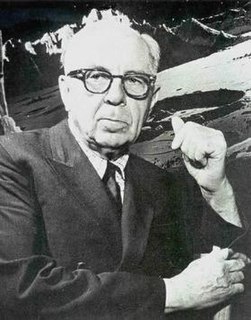
Chesley Knight Bonestell, Jr. was an American painter, designer and illustrator. His paintings inspired the American space program, and they have been influential in science fiction art and illustration. A pioneering creator of astronomical art, along with the French astronomer-artist Lucien Rudaux, Bonestell has been dubbed the "Father of Modern Space art".

John Stewart Williamson, who wrote as Jack Williamson, was an American science fiction writer, often called the "Dean of Science Fiction". He is also credited with one of the first uses of the term "genetic engineering". Early in his career he sometimes used the pseudonyms Will Stewart and Nils O. Sonderlund.

James Hannigan is a multi-award winning British composer, sound designer, music producer and live event creative director. His work as a composer has included single or multiple entries in the multi-million selling Command & Conquer, Harry Potter, The Lord of the Rings, Dead Space, Warhammer, Wing Commander, Space Hulk, Evil Genius, Grand Prix and Theme Park game series; video games including Freelancer, RuneScape, Cloudy with a Chance of Meatballs, Dead Space 3, The Transformers Universe,Command & Conquer: Red Alert 3, Republic: The Revolution,Sim Theme Park , Wing Commander: Privateer 2: The Darkening, Conquest: Frontier Wars, Nintendo's Art Academy, Reign of Fire, The Lord of the Rings: Aragorn's Quest, and others, along with television such as BBC America’s Primeval. He has also contributed music to EA Sports titles, such as those belonging to the FIFA and F1 series and his music has minimally been heard in games such as Super Smash Bros. for Nintendo 3DS and Wii U and Saints Row 4. In the early years of his career, Hannigan worked as Composer for Electronic Arts Europe before basing his studio at Pinewood Studios in England for ten years between 1997 and 2007, where he sometimes worked as a Sound Designer on films such as Lost in Space (film) alongside composing.

Conquest of Space is a 1955 American Technicolor science fiction film from Paramount Pictures, produced by George Pal, directed by Byron Haskin, that stars Walter Brooke, Eric Fleming, and Mickey Shaughnessy.
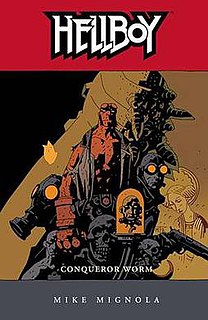
Hellboy: Conqueror Worm is a Hellboy comic book mini-series, written and drawn by Mike Mignola and published by Dark Horse Comics.
"Man Will Conquer Space Soon!" was the title of a famous series of 1950s magazine articles in Collier's detailing Wernher von Braun's plans for manned spaceflight. Edited by Cornelius Ryan, the individual articles were authored by such space notables of the time as Willy Ley, Fred Lawrence Whipple, Dr. Joseph Kaplan, Dr. Heinz Haber, and von Braun. The articles were illustrated with paintings and drawings by Chesley Bonestell, Fred Freeman, and Rolf Klep, some of the finest magazine illustrators of the time.
Christy Marx is an American screenwriter, author, and game designer, best known for her work on various TV series including Jem, Teenage Mutant Ninja Turtles, Conan the Adventurer, G.I. Joe, Hypernauts, and Captain Power. She is also known for her original comic book series Sisterhood of Steel as well as work on Conan, Red Sonja, and Elfquest. Marx has also authored several biographies and history books.
A conqueror is a person who conquers.
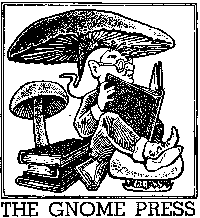
Gnome Press was an American small-press publishing company primarily known for publishing many science fiction classics. Gnome was one of the most eminent of the fan publishers of SF, producing 86 titles in its lifespan — many considered classic works of SF and Fantasy today. Gnome was important in the transitional period between Genre SF as a magazine phenomenon and its arrival in mass-market book publishing, but proved too underfunded to make the leap from fan-based publishing to the professional level. The company existed for just over a decade, ultimately failing due to inability to compete with major publishers who also started to publish science fiction. In its heyday, Gnome published many of the major SF authors, and in some cases, as with Robert E. Howard's Conan series and Isaac Asimov's Foundation series, was responsible for the manner in which their stories were collected into book form.
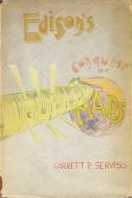
Edison's Conquest of Mars is an 1898 science fiction novel by American astronomer and writer Garrett P. Serviss. It was written as a sequel to Fighters from Mars, an unauthorized and heavily altered version of H. G. Wells's 1897 story The War of the Worlds. It has a place in the history of science fiction for its early employment of themes and motifs that later became staples of the genre.
Robert Moore Williams was an American writer, primarily of science fiction. Pseudonyms included John S Browning, H. H. Harmon, Russell Storm and E. K. Jarvis.

Antarctic Conquest: the Story of the Ronne Expedition 1946-1948 is a 1949 science book by Norwegian-American Antarctic explorer Finn Ronne and science fiction writer L. Sprague de Camp, published in hardcover by G. P. Putnam's Sons. The role of de Camp, who was commissioned as a ghost writer to recast Ronne's manuscript into publishable form, is uncredited. Ronne's working title was reportedly "Conquering the Antarctic".

David Lasser was an American writer and political activist. Lasser is remembered as one of the most influential figures of early science fiction writing, working closely with Hugo Gernsback. He was also heavily involved in the workers’ rights struggles of the Great Depression.
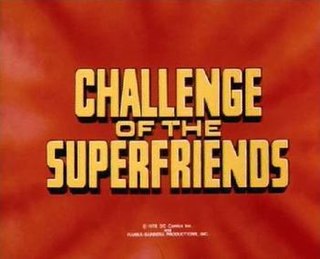
Challenge of the Superfriends is an American animated television series about a team of superheroes which ran from September 9, 1978, to December 23, 1978, on ABC. The complete series was produced by Hanna-Barbera Productions and is based on the Justice League and associated comic book characters published by DC Comics and created by Julius Schwartz, Gardner Fox and Mike Sekowsky. It was the third series of Super Friends cartoons, following the original Super Friends in 1973 and The All-New Super Friends Hour in 1977.

Annihilation: Conquest is a 2007–08 Marvel Comics crossover storyline and the sequel to 2006's "Annihilation". The series again focuses on Marvel's cosmic heroes defending the universe against the Phalanx, now led by Ultron. Nova returns once more in a title role, along with Quasar, Star-Lord, and a new character called Wraith.
The Legion of Space is a space opera science fiction series by American writer Jack Williamson. The story takes place in an era when humans have colonized the Solar System but dare not go farther, as the first extra-solar expedition to Barnard's Star failed and the survivors came back as babbling, grotesque, diseased madmen. They spoke of a gigantic planet, populated by ferocious animals and the single city left of the evil "Medusae". The Medusae bear a vague resemblance to jellyfish, but are actually elephant-sized, four-eyed, flying beings with hundreds of tentacles. The Medusae cannot speak, and communicate with one another via a microwave code.
Skylark is a science fiction/space opera series by American writer E. E. Smith. In the first book, The Skylark of Space, a scientist discovers a space-drive, builds a starship, and flies off with three companions to encounter alien civilizations and fight a larger-than-life villain.
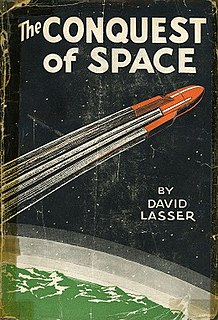
The Conquest of Space is a nonfiction book written by David Lasser in 1930 and self-published in 1931. It was the first book written in English that presented rocketry and spaceflight in a serious manner. The book profiles a fictional journey to the Moon to explain the science of rocketry as it stood in 1931. It uses contemporary knowledge on rockets to create a reasonable description of the hardware necessary to make spaceflight possible. The book was out of print until 2002, when it was republished by Apogee Books. As of 2011, the book remains in print.











